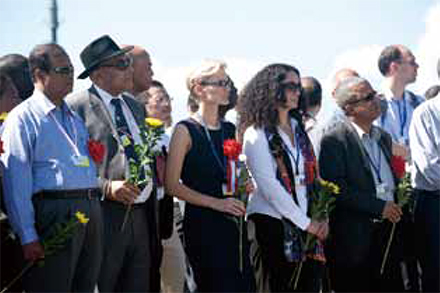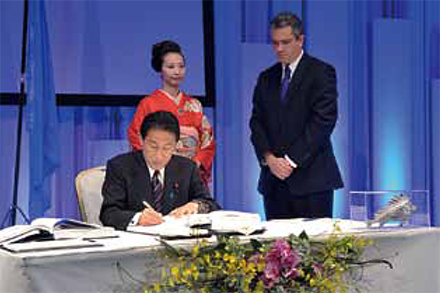Diplomatic Bluebook 2014 Summary
Chapter 3
Japan’s Foreign Policy to Promote National
and Worldwide Interests Attendees from around the world at the flower offering ceremony (October 9, 2013, Minamata; Source: Ministry of the Environment)
Attendees from around the world at the flower offering ceremony (October 9, 2013, Minamata; Source: Ministry of the Environment)
 Minister for Foreign Affairs Kishida signing the Minamata Convention (October 10, Kumamoto)
Minister for Foreign Affairs Kishida signing the Minamata Convention (October 10, Kumamoto)
1. About the Convention
The Minamata Convention on Mercury is a global legally binding instrument that covers the whole lifecycle of mercury, including its mining, use in products, waste management and disposal. It is the first treaty by the international community to comprehensively regulate a single substance
2. The Diplomatic Conference for the Minamata Convention on Mercury
The Conference of the Plenipotentiaries for the Minamata Convention on Mercury and its preparatory meetings were held in the cities of Kumamoto and Minamata on October 7–11, 2013. More than 1,000 people attended the conference, including government officials from about 140 countries and regions, with ministers from more than 60 countries, as well as representatives from international organizations and NGOs.
The opening ceremony was held in Minamata on October 9. Prime Minister Shinzo Abe, in his message, called for the eradication of harm from mercury, and pledged a total of US$2 billion over the next three years in assistance from Japan to support anti-pollution measures in developing countries. Prior to this ceremony, attendees from around the world placed flowers at the memorial monument, planted trees, and visited organizations and facilities related to Minamata disease.
The Conference of the Plenipotentiaries on October 10–11 was chaired by Minister of the Environment Nobuteru Ishihara, where the Minamata Convention on Mercury was unanimously adopted. Minister for Foreign Affairs Fumio Kishida signed the convention for Japan. He further announced specific plans for the US$2 billion in aid, along with new measures to support human resource development specializing in preventing mercury contamination, expressing a resolve to realize a world free of mercury pollution.
3. Significance of the Diplomatic Conference on the Minamata Convention on Mercury
The attendance at the diplomatic conference by ministers from more than 60 countries and 92 signatories (including European Union) reveal the strong interest of the international community in the mercury regulation. Based on the lessons of Minamata disease, Japan has participated in the negotiations with firm determination that the same sort of damage to health and environmental pollution should never recur. The fact that Japan hosted the Diplomatic Conference for the Minamata Convention on Mercury is of great significance to demonstrate the country’s resolve to the international community.
The convention was also an important opportunity for Japan to share with the world its experience and show its technology to the world in the environmental field.

